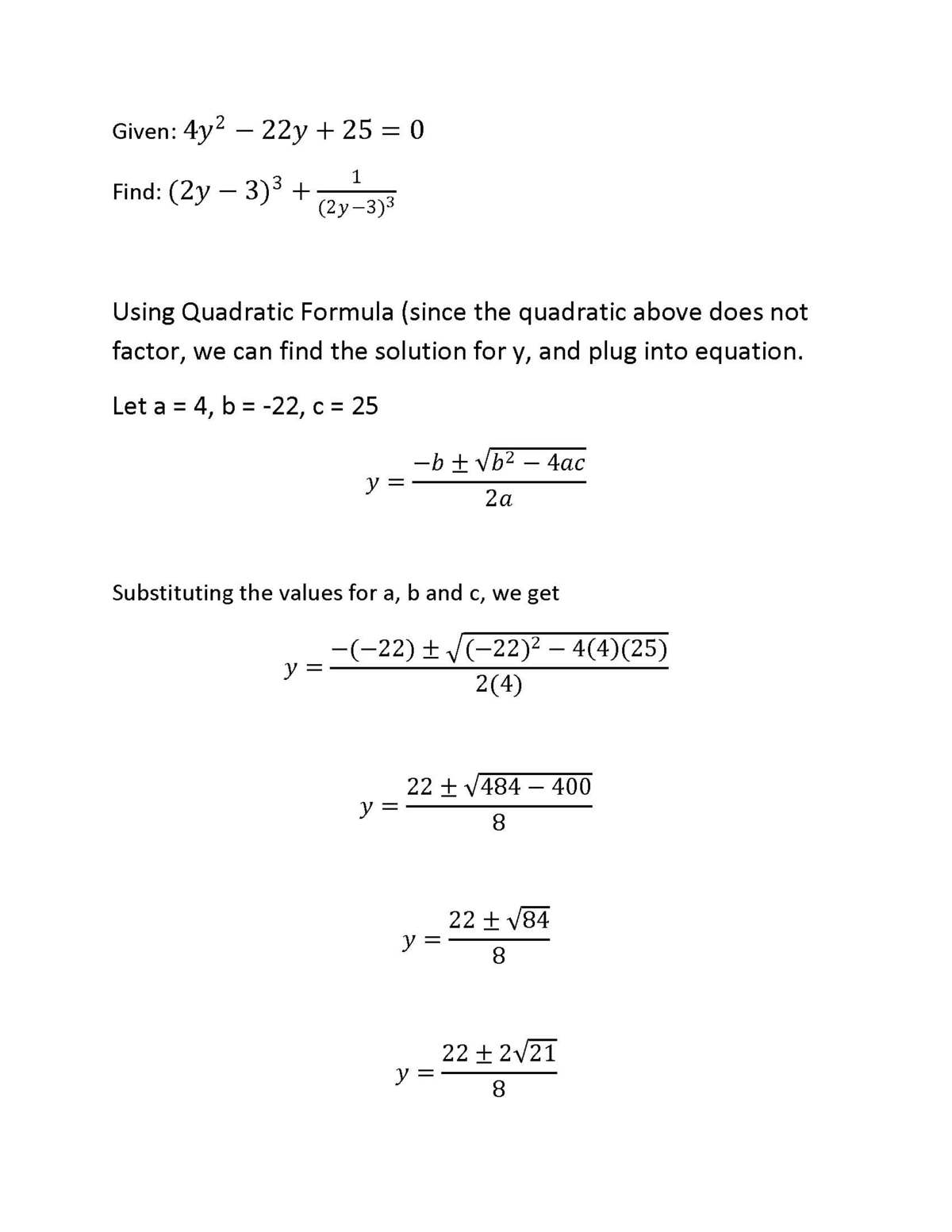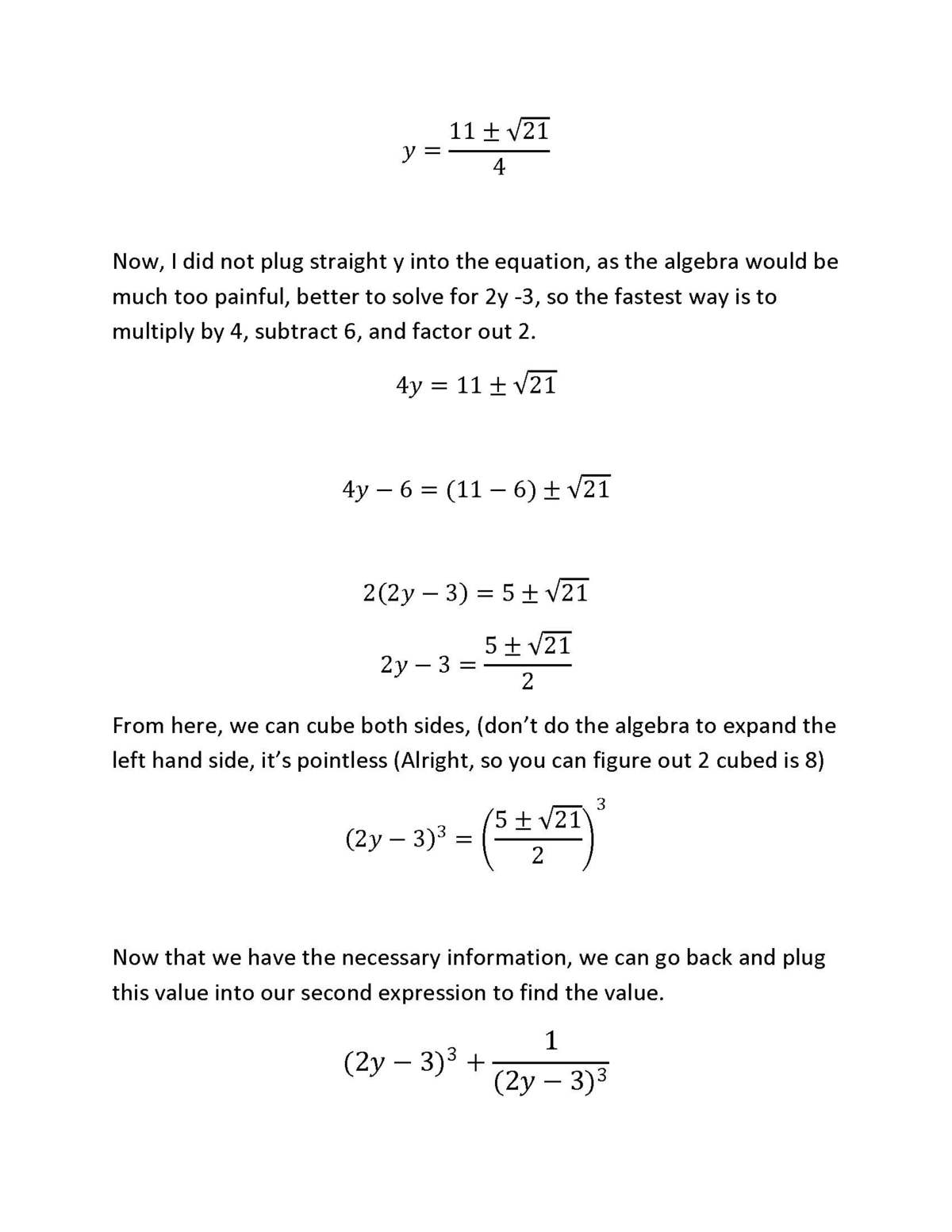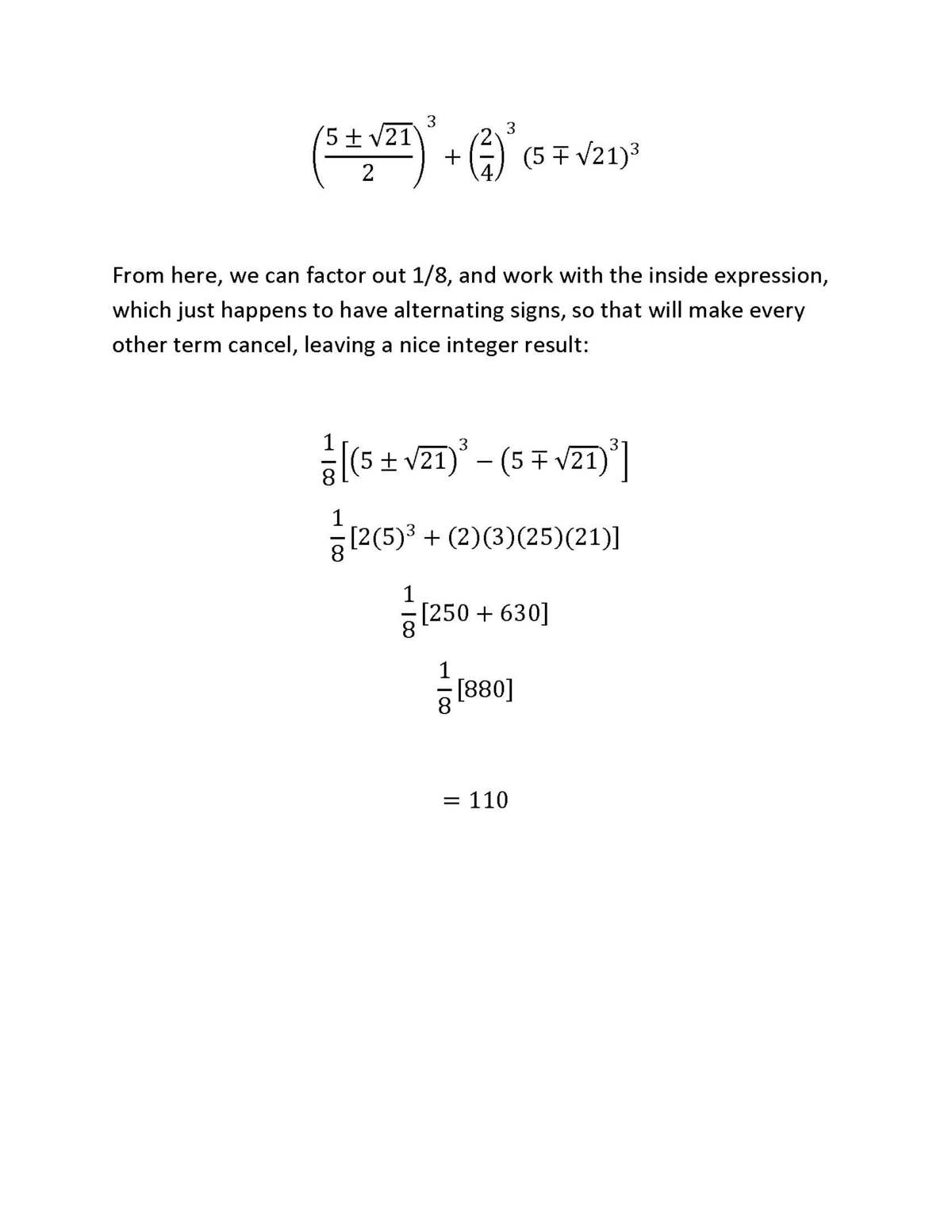Evaluate
4 y 2 − 2 2 y + 2 5 = 0 , ( 2 y − 3 ) 3 + ( 2 y − 3 ) 3 1 = ?
The answer is 110.
This section requires Javascript.
You are seeing this because something didn't load right. We suggest you, (a) try
refreshing the page, (b) enabling javascript if it is disabled on your browser and,
finally, (c)
loading the
non-javascript version of this page
. We're sorry about the hassle.
7 solutions
Sir can you tell us how to get to know what to split ,
I mean splitting 22y into -12 y - 10 y .
Is there a way to think or any hints etc, if similar algebraic problem raised in future.
Log in to reply
It is clearly shown in the second equation that ( 2 y − 2 ) is an important factor. We just need to manipulate the first equation to fit.
Log in to reply
Thank you .
Typoe. ( 2 y − 3 ) .
It is just 12th class algebra.
Log in to reply
lol, I did this question with Quadratic formula.
Beautifull. Nice simple solution,
4 y 2 − 2 2 y + 2 5 4 y 2 − 1 2 y + 1 0 ( 2 y − 3 ) 3 + ( 2 y − 3 ) 3 1 = 0 = 1 0 y − 1 5 = ( 2 y − 3 + 2 y − 3 1 ) 3 − 3 ( 2 y − 3 + 2 y − 3 1 ) = ( 2 y − 3 ( 2 y − 3 ) 2 + 1 ) 3 − 3 ( 2 y − 3 ( 2 y − 3 ) 2 + 1 ) = ( 2 y − 3 4 y 2 − 1 2 y + 1 0 ) 3 − 3 ( 2 y − 3 4 y 2 − 1 2 y + 1 0 ) = ( 2 y − 3 1 0 y − 1 5 ) 3 − 3 ( 2 y − 3 1 0 y − 1 5 ) = 5 3 − 3 . 5 = 1 1 0
Great Rohit
Beautifull. Nice simple solution,
If 4 y 2 − 2 2 y + 2 5 = 0 then, using the quadratic formula, y = 4 1 ( 1 1 ± 2 1 ) . Substitute y = 4 1 ( 1 1 + 2 1 ) into the second expression and arrive at 5 5 + 1 2 2 1 + 5 5 − 1 2 2 1 which equals 1 1 0 .
right, which means this could also equal 125. Unless I'm horribly mistaken, this was a horrible question, they imply that a second degree quadratic has only one solution. Obviously a parabola has 2 roots not one.
Log in to reply
When you substitute y = 4 1 ( 1 1 − 2 1 ) into the expression, you still get 110.
A lot of calculations. Its tedious and needs patience. Good Job
Using 4 y 2 − 2 2 y + 2 5 = 0 , I simplified the second expression into 4 8 y − 7 7 + 1 / ( 4 8 y − 7 7 ) . This made it easier for me to substitute in ( 1 1 ± s q r t ( 2 1 ) ) / 4 .
I did this solution the painful way, here is my solution




4y^{ 2 }-22y+25=0,\ y=\frac { -(-22)\pm \sqrt { (-22)^{ 2 }-\quad 4(4)(25) } }{ 2(4) } \Longrightarrow \frac { 11\pm \sqrt { 21 } }{ 4 } \ Substituting\quad into\quad equation\quad gives\quad answer\quad :\quad \boxed { 110 }
I did things the hard way. I inserted y values in smaller and smaller increments until my answers came close to zero. Ending up getting close when inserting the y value of y = 1.605 into the second problem. I guessed the answer from there until I got 110 on my last guess.
The answer is also 125. The parabola has 2 roots! quadratic equation: [22+/-sqrt(484-400)]/8=> y=1.60 and y=3.89. Since neither of the roots make the second equation undefined, there are two answers: (2y-3)^3+1/(2y-3)^3=> 110 when y=1.60 & 125 when y=3.89.
(2 * 3,895643923738960001647011798432 - 3) ^ 3 + 1 / ((2 * 3,895643923738960001647011798432 - 3) ^ 3 ) = 109,99090833947008007905656632474 + 1/109,99090833947008007905656632474 = 110
So, you are horribly mistaken. With both roots we get 110, but there is some smarter way to solve like Chew-Seong Cheong show us.
Let x = 2 y − 3 . We note that:
4 y 2 − 2 2 y + 2 5 4 y 2 − 1 2 y + 9 − 1 0 y + 1 6 ( 2 y − 3 ) 2 − 5 ( 2 y − 3 ) + 1 ⇒ x 2 − 5 x + 1 x + x 1 = 0 = 0 = 0 = 0 = 5
Now, we have:
( 2 y − 3 ) 3 + ( 2 y − 3 ) 3 1 = x 3 + x 3 1 = ( x + x 1 ) ( x 2 + x 2 1 − 1 ) = ( x + x 1 ) ( [ x + x 1 ] 2 − 2 − 1 ) = 5 ( 5 2 − 3 ) = 1 1 0